Which Terrestrial Geographic Zones Tend To Have The Highest Plant And Animal Biodiversity
What constitutes a biome?
A biome consists of all the habitats of a community that make up similar ecosystems in a detail region.
Learning Objectives
Differentiate biomes from other levels of ecological nomenclature, including habitat
Key Takeaways
Key Points
- The climate, including precipitation and temperature, and the geography control the type of biome institute in a region.
- There are two major classifications of biomes, which are terrestial and aquatic, and these include the types of biomes known every bit deserts, forests, grasslands, savannas, tundra, and freshwater environments.
- A habitat is the location where a grouping of one type of organism (a population ) lives, while a biome is a community fabricated of all the habitats in a given region and climate.
- Different organisms inhabit different types of biomes.
- Each type of biome can be constitute in multiple locations on Globe depending on its climate, geography, and organisms.
Fundamental Terms
- biome: whatever major regional biological community such as that of forest or desert
- ecotone: a transition expanse between 2 adjacent ecosystems
- habitat: a specific place or natural conditions in which a plant or animal lives
- population: a collection of organisms of a detail species, sharing a particular characteristic of interest, most oftentimes that of living in a given surface area
- ecosystem: a organisation formed by an ecological customs and its surround that functions as a unit
What Constitutes a Biome?
A group of living organisms of the aforementioned kind that live in the same place simultaneously is known as a population. Populations live together in habitats, which together make upwardly a community. An ecosystem is a customs of living organisms interacting with the not-living components of that surroundings.
A biome is a community on a global calibration, where habitats flank each other, and is usually defined by the temperature, atmospheric precipitation, and types of plants and animals that inhabit information technology. The Earth's biomes are categorized into 2 major groups: terrestrial and aquatic. Terrestrial biomes are based on land, while aquatic biomes include both ocean and freshwater biomes. The major types of biomes include: aquatic, desert, forest, grassland, savannas, and tundra.
Biome Attributes
Generally, biome nomenclature is adamant by the climate and geography of an area. Each biome consists of communities that have adapted to the unlike climate and environment inside the biome. Specifically, there are special vegetation adaptations as well as physical and behavioral adaptions made by animals in order to accommodate the environment. The eight major terrestrial biomes on Earth are each distinguished past characteristic temperatures and corporeality of precipitation. Comparing the annual totals of precipitation and fluctuations in precipitation from 1 biome to another provides clues as to the importance of abiotic factors in the distribution of biomes. Temperature variation on a daily and seasonal footing is also important for predicting the geographic distribution of the biome and the vegetation type in the biome.
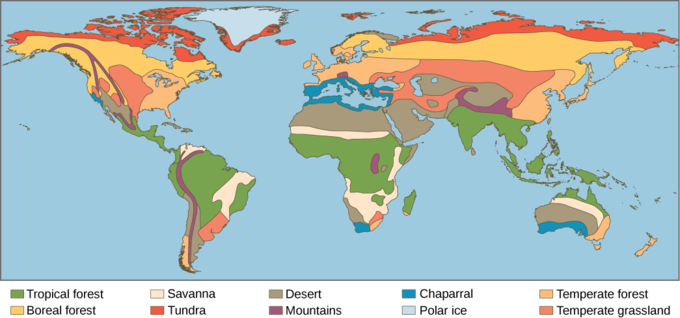
Earth's Major Biomes: Each of the earth's major biomes is distinguished by characteristic temperatures and amounts of atmospheric precipitation. Each blazon of biome can be found in multiple places.
The distribution of these biomes shows that the same biome can occur in geographically singled-out areas with similar climates. Biomes take no distinct boundaries. Instead, there is a transition zone called an ecotone, which contains a variety of plants and animals. For example, an ecotone might be a transition region between a grassland and a desert, with species from both.
Tropical Wet Forest and Savannas
Tropical wet forests are characterized by high precipitation and humidity, while savannas take scattered copse and an extensive dry season.
Learning Objectives
Recognize the distinguishing characteristics of tropical wet forests and savannas
Key Takeaways
Primal Points
- Tropical wet forests, located near the equator, have temperatures that range from twenty°C - 34°C (68°F - 93°F), with little variation in seasonal temperatures.
- The lack of seasonality, constant daily sunlight, platonic temperatures, and loftier rate of precipitation in tropical wet forests lead to increased plant growth and loftier species diversity.
- The almanac rainfall in tropical wet forests ranges from 125 to 660 cm (50–200 in); there is a high rate of precipitation even in the dry out months.
- Savannas, grasslands with scattered trees, are located in Africa, South America, and northern Australia.
- Temperatures in savannas range from 24°C - 29°C (75°F - 84°F), with almanac rainfall ranges from 10–40 cm (three.9–15.vii in).
- Because savannas are very dry, trees do non grow as well as they do in other woods biomes and diversity is minimal.
Central Terms
- deciduous: of or pertaining to copse which lose their leaves in winter or the dry out flavour
- biome: any major regional biological community such as that of forest or desert
- understory: the layer of plants that grow in the shade of the canopy of a forest
Tropical Wet Wood
Tropical wet forests, too referred to as tropical rainforests, are found in equatorial regions. The vegetation is characterized by plants with broad leaves that fall off throughout the year. Dissimilar the trees of deciduous forests, the trees in this biome exercise not take a seasonal loss of leaves associated with variations in temperature and sunlight; these forests are "evergreen" year-round.
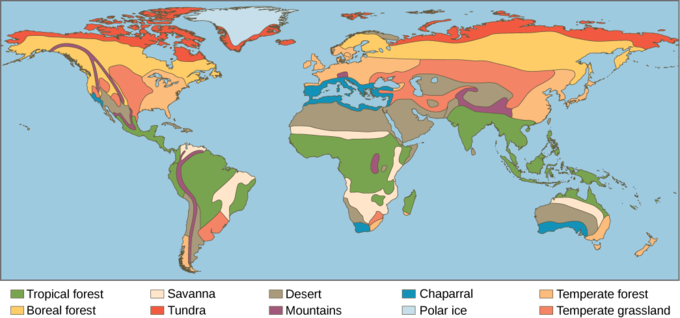
Terrestrial biomes: Each of the earth's major biomes is distinguished past feature temperatures and amounts of atmospheric precipitation. Polar ice and mountains are also shown. Tropical wet forests are depicted in dark-green and are usually plant at equatorial regions. Savannas are depicted in light pinkish and are ordinarily located in Africa, Southward America, and Northern Australia.
The temperature and sunlight profiles of tropical wet forests are very stable in comparison to that of other terrestrial biomes, with the temperatures ranging from xx°C - 34°C (68°F - 93°F). Compared to other wood biomes, tropical wet forests have piffling variation in seasonal temperatures. This lack of seasonality leads to year-round plant growth, rather than the seasonal (spring, summertime, and fall) growth seen in other biomes. In contrast to other ecosystems, tropical ecosystems do not accept long days and short days during the yearly cycle. Instead, a constant daily amount of sunlight (eleven–12 hrs per day) provides more than solar radiation and, thereby, a longer period of time for plant growth.
The annual rainfall in tropical wet forests ranges from 125-660 cm (l–200 in), with some monthly variation. While sunlight and temperature remain fairly consistent, annual rainfall is highly variable. Tropical wet forests have wet months in which at that place can be more than 30 cm (11–12 in) of precipitation, as well as dry out months in which there are fewer than 10 cm (3.5 in) of rainfall. Yet, the driest month of a tropical moisture forest nonetheless exceeds the almanac rainfall of some other biomes, such as deserts.
Tropical wet forests have high cyberspace primary productivity because the annual temperatures and precipitation values in these areas are ideal for plant growth. Therefore, the extensive biomass present in the tropical moisture wood leads to found communities with very high species diversity. Tropical moisture forests have more species of trees than whatever other biome. On average, betwixt 100 and 300 species of trees are nowadays in a single hectare (2.five acres) of Southward America. Ane way to visualize this is to compare the distinctive horizontal layers within the tropical moisture wood biome. On the woods floor is a sparse layer of plants and decaying found matter. In a higher place that is an understory of short shrubby foliage. A layer of trees ascension higher up this understory is topped by a closed upper canopy: the uppermost overhead layer of branches and leaves. Some boosted copse emerge through this airtight upper canopy. These layers provide diverse and complex habitats for the diverseness of plants, fungi, animals, and other organisms inside the tropical wet forests. For instance, epiphytes are plants that grow on other plants. Host plants are typically unharmed. Epiphytes are plant throughout tropical moisture woods biomes. Many species of animals utilise the variety of plants and the circuitous construction of the tropical wet forests for food and shelter. Some organisms alive several meters above basis, having adapted to this arboreal lifestyle.
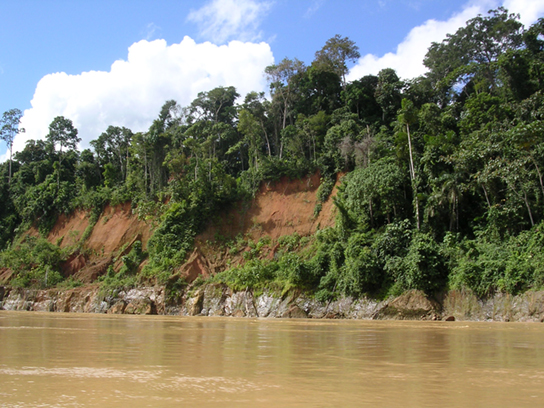
Tropical wet forests: Tropical wet forests, such as the forests of Madre de Dios near the Amazon River in Republic of peru, have high species variety.
Savannas
Savannas are grasslands with scattered copse located in Africa, South America, and northern Australia. Savannas are hot, tropical areas with temperatures averaging from 24°C - 29°C (75°F - 84°F) and an annual rainfall of ten–40 cm (3.9–15.7 in). They take an extensive dry flavor. For this reason, wood trees do not grow also as they do in the tropical wet forest or other forest biomes. As a result, there are relatively few trees within the grasses and forbs (herbaceous flowering plants) that dominate the savanna. Since fire is an important source of disturbance in this biome, plants have evolved well-developed root systems that allow them to quickly re-sprout afterwards a fire.
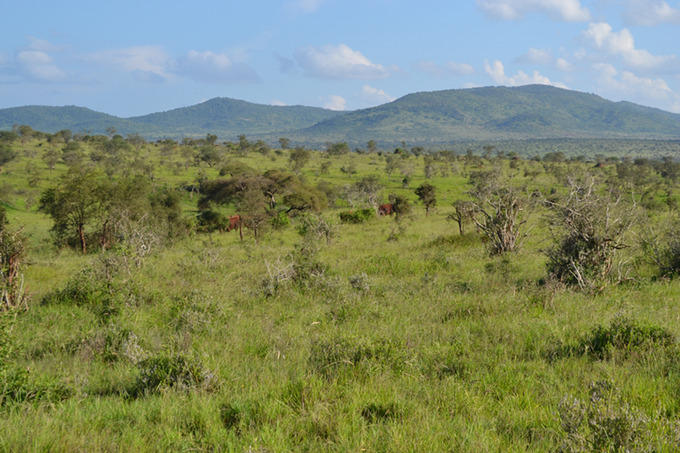
Savannas: Savannas, such as this one in Taita Hills Wildlife Sanctuary in Kenya, are dominated by grasses.
Animals commonly found in savannas in Africa include the African elephant, lions, gazelles, giraffes, ostriches, and many other mammals, birds, plants and invertebrates. The northern Australian savannas also take many types of plants, animals, insects, and reptiles, including marsupials (kangaroos and wallabies), bats, and rodents. In addition to the native animals such as foxes and Patagonian maras (rabbit-like rodents), savannas in South America are ordinarily used for grazing domestic livestock, such as sheep, goats, and cattle considering of their open grasslands and herbaceous layer of plants.
Subtropical Deserts and Chaparral
Subtropical deserts are characterized by their dry out environments, while chaparrals are characterized past the presence of shrubs.
Learning Objectives
Recognize the distinguishing characteristics of subtropical deserts and chaparrals
Key Takeaways
Key Points
- Subtropical deserts are centered on the Torrid zone of Cancer and Capricorn.
- Subtropical deserts can be hot or cold, just they are all very dry,having very low almanac precipitation.
- Because precipitation is so low in subtropical deserts, most plants are annuals which apply adaptations to conserve water.
- Chaparrals (scrub forests) are found in California, along the Mediterranean Sea, and along the southern coast of Australia.
- Chaparrals are very wet in the wintertime, simply very dry out in the summer months; most chaparral plants stay dormant during the summer.
- Most chaparral plants are shrubs adjusted to fires; some seeds only germinate after a fire.
Key Terms
- chaparral: a region of shrubs, typically dry in the summer and rainy in the winter
- subtropical desert: dry region centered on the Tropics of Cancer and Capricorn where evaporation exceeds precipitation
Subtropical Deserts
Subtropical deserts, which exist between 15° and 30° due north and south latitude, are centered on the Tropics of Cancer and Capricorn. In some years, evaporation exceeds precipitation in this very dry biome. Subtropical hot deserts may have daytime soil surface temperatures above 60°C (140°F) and night temperatures approaching 0°C (32°F). In cold deserts, temperatures may be as high as 25°C (77°F) and may driblet beneath -thirty°C (-22°F). Subtropical deserts are characterized by low annual precipitation of fewer than 30 cm (12 in), with little monthly variation and lack of predictability in rainfall. In some cases, the annual rainfall can be as low as 2 cm (0.8 in), such as in central Commonwealth of australia ("the Outback") and northern Africa.
Types of Deserts
There are several types of deserts including loftier-pressure deserts, mid-continent deserts, rain-shadow deserts, and upwelling deserts. In loftier-pressure deserts, the high atmospheric pressure enables the air to retain more than moisture and in that location is little rainfall. High-pressure deserts include the Sahara, Arabian, Thar, and Kalahari deserts, and the desert regions within the Chill and Antarctic circles. Areas in the centre of a continent can receive little rainfall considering moisture tends to condense earlier it reaches the middle of a large continent. Modern examples of mid-continent deserts are the Turkmenistan, Gobi, and Bully Australian deserts. Third, rain-shadow deserts are created when wet from the ocean condenses on 1 side of a mountain range. These mountain ranges usually take a rainforest on one side and a desert on the other. Examples of rain-shadow deserts include the Mojave desert in the rain-shadow of the Sierra Nevada, the Patagonian desert in the pelting-shadow of the Andes, and the Iranian desert in the rain-shadow of the Zagros mountains. Finally, upwelling deserts be adjacent to areas where cold currents rise to the ocean surface, reducing evaporation. Examples include the Atacama desert, the Western Sahara, and the Namib desert.
Adaptations for Deserts
The blazon of vegetation and limited animal diverseness of this biome are closely related to the low and unpredictable atmospheric precipitation. Very dry deserts lack perennial vegetation that lives from one year to the next. Instead, many plants are annuals that abound rapidly, reproduce when rainfall does occur, and and then dice. Many other plants in these areas are characterized by having a number of adaptations that conserve water, such equally deep roots, reduced foliage, and water-storing stems. Seed plants in the desert produce seeds that can remain in dormancy for extended periods between rains. To reduce water loss and conserve energy, many desert animals like the fennec fox are nocturnal and burrow during the day.
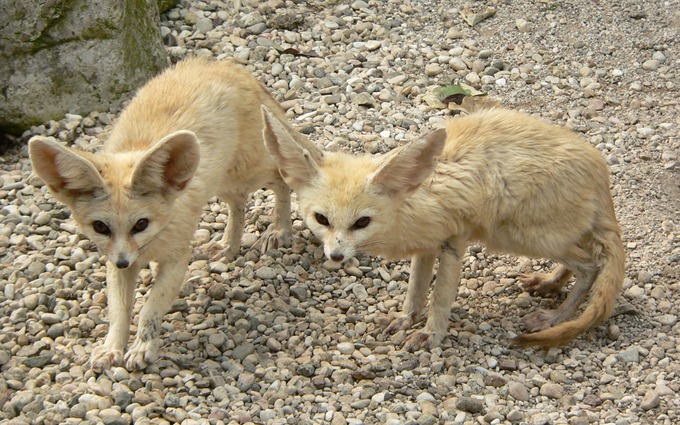
Fennec fox: Fennec foxes live in the deserts of Northern Africa and have large ears for heat dissipation during the day. They stay in burrows during the day and are more often than not active at night.
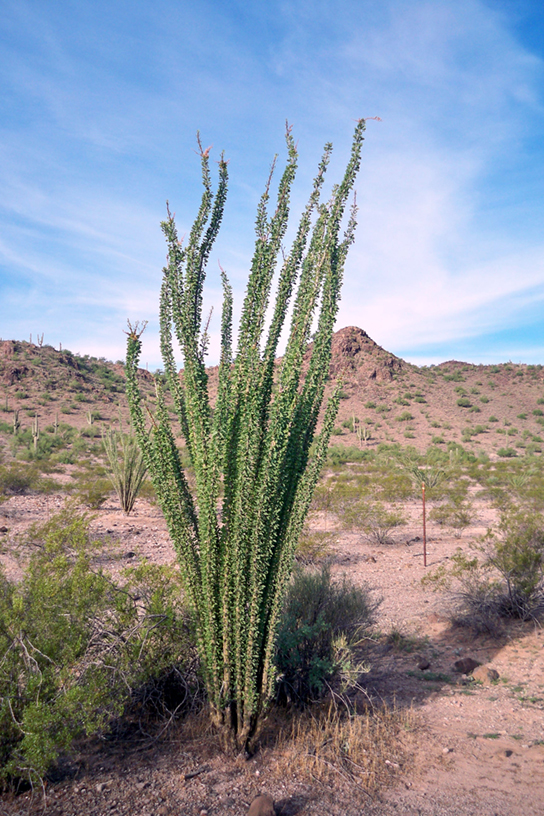
Desert plants: To reduce water loss, many desert plants have tiny leaves or no leaves at all. The leaves of ocotillo (Fouquieria splendens), shown here in the Sonora Desert near Gila Curve, Arizona, announced simply later rainfall then are shed.
Chaparral
The chaparral, also called the scrub forest, is found in California, along the Mediterranean Ocean, and along the southern coast of Commonwealth of australia. The annual rainfall in this biome ranges from 65 cm to 75 cm (25.six–29.5 in), with the bulk of rain falling in the winter. Due to the very dry summers, many chaparral plants are dormant during that season. The chaparral vegetation is dominated past shrubs and is adapted to periodic fires, with some plants producing seeds that but germinate later a hot fire. The ashes left behind after a fire are rich in nutrients, such as nitrogen, that fertilize the soil and promote plant regrowth.
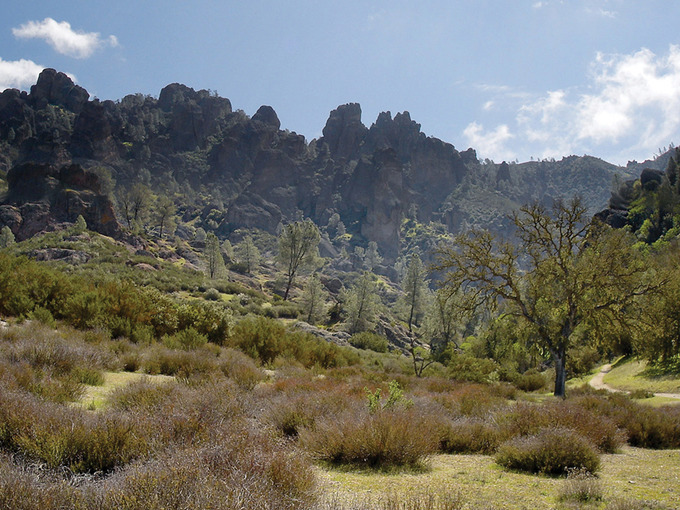
Chaparrals: The chaparral, or scrub forest, is dominated by shrubs adjusted to periodic fires. Some plants produce seeds that only germinate later on a hot burn.
Temperate Grasslands
Temperate grasslands are areas with depression annual precipitation, fluctuating seasonal temperatures, and few trees.
Learning Objectives
Recognize the distinguishing characteristics of temperate grasslands
Cardinal Takeaways
Cardinal Points
- Temperate grasslands are found throughout fundamental North America, where they are also known as prairies; they are likewise institute in Eurasia, where they are known as steppes.
- Temperate grasslands take hot summers and cold winters; the growing season occurs during the jump, summer, and fall.
- Because of the low annual atmospheric precipitation, temperate grasslands accept very few trees.
- Grasses are the ascendant vegetation; their roots and rhizomes provide increased fertility to the soil.
- Fires acquired by lightening occur ofttimes in grasslands; without fires grasslands are converted to scrub forests.
Key Terms
- steppe: the grasslands of Eastern Europe and Asia
- prairie: an extensive area of relatively apartment grassland with few, if whatsoever, trees, particularly in N America
Temperate Grasslands
Temperate grasslands are plant throughout fundamental Northward America, where they are also known every bit prairies, and within Eurasia, where they are known as steppes. Temperate grasslands accept pronounced annual fluctuations in temperature, with hot summers and cold winters. The annual temperature variation produces specific growing seasons for plants. Found growth is possible when temperatures are warm enough and when ample water is bachelor to sustain it, which typically occurs in the spring, summer, and fall. During much of the winter, temperatures are low and h2o, which is stored in the form of ice, is not bachelor for plant growth.
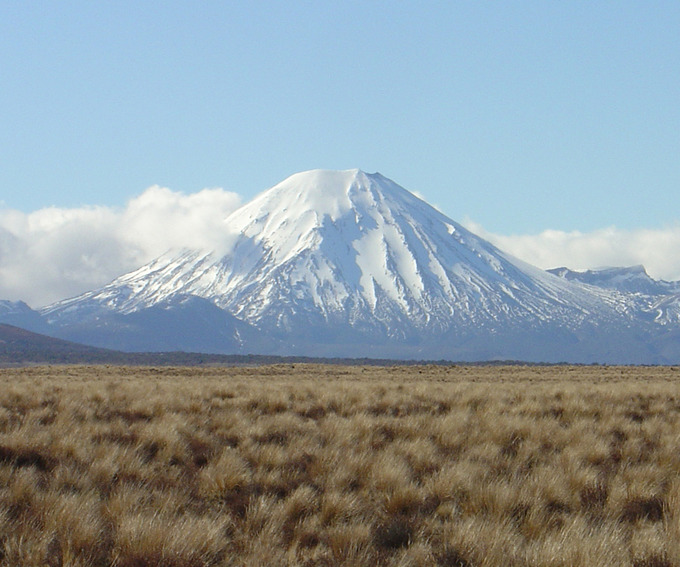
Temperate grasslands in New Zealand: Temperate tussock grasslands form expansive and distinctive landscapes in the S Island and to a lesser extent in the central plateau region of the North Island of New Zealand.
Annual precipitation ranges from 25 cm to 75 cm (9.8–29.v in). Because of relatively-lower almanac precipitation in temperate grasslands, there are few copse, except for those found growing along rivers or streams. The dominant vegetation tends to consist of grasses; some prairies sustain populations of grazing animals. The vegetation is very dense and the soils are fertile because the subsurface of the soil is packed with the roots and rhizomes (underground stems) of these grasses, which ballast plants into the footing and furnish the organic material (humus) in the soil when they dice and disuse.
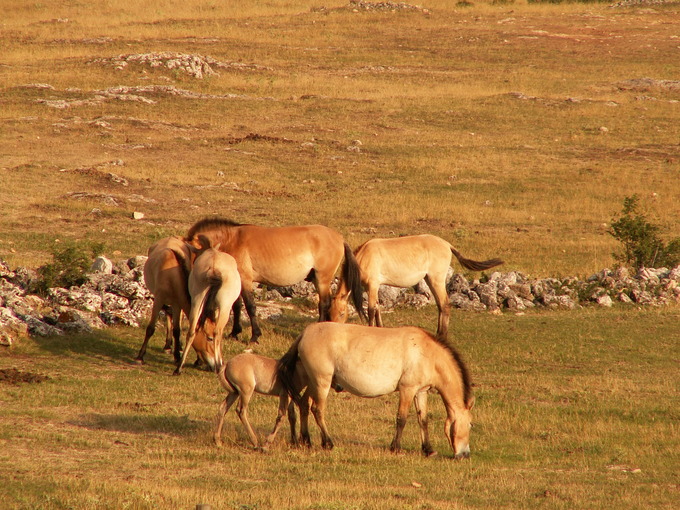
Przewalski'due south horses on the Asian steppes: The Przewalski's horse is a rare and endangered subspecies of wild horse. By the end of the 1950s, only 12 individual Przewalski's horses were left in the world and several reintroduction programs have released populations back into the grasslands in Mongolia and Ukraine.
Fires, mainly caused by lightning, are a natural disturbance in temperate grasslands. When burn is suppressed, the vegetation eventually converts to scrub and dense forests. Often, the restoration or management of temperate grasslands requires the employ of controlled burns to suppress the growth of trees and maintain the grasses. Called-for causes new grass to grow, which brings back the grazing animals.
Organisms Found in Temperate Grasslands
Mites, insect larvae, nematodes and earthworms inhabit deep soil, which tin reach half dozen meters (20 ft) clandestine in undisturbed grasslands on the richest soils of the world. These invertebrates, along with symbiotic fungi, extend the root systems, break apart hard soil, enrich it with urea and other natural fertilizers, trap minerals and water, and promote growth. Some types of fungi make the plants more resistant to insect and microbial attacks. Grasslands likewise are dwelling house to a vast variety of mammals, reptiles, birds, and insects. Typical large mammals include the Giant Anteater and populations of grazing animals, such as the Blue Wildebeest, Przewalski'due south Horse, and the American Bison.
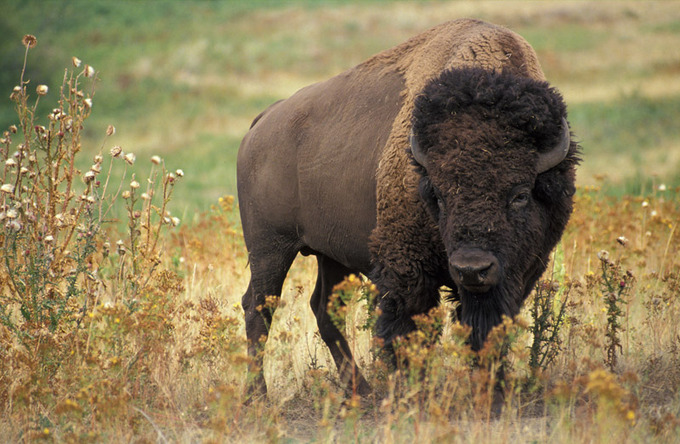
Grazing animals: The American bison (Bison bison), more normally called the buffalo, is a grazing mammal that once populated American prairies in huge numbers.
Temperate Forests
Temperate forests are characterized by fluctuating seasonal temperatures and constant-but-moderate rainfall.
Learning Objectives
Recognize the distingushing chracteristics of temperate forests
Key Takeaways
Key Points
- Temperate forests are the about mutual biome in eastern Northward America, Western Europe, East asia, Republic of chile, and New Zealand.
- Temperatures in temperate forests fluctuate; there are defined growing seasons during bound, summer, and early fall.
- Because temperate forests have moderate almanac precipitation, the ascendant plants are the deciduous copse.
- Deciduous trees experience a fallow flow in the winter, which is why temperate forests take less net productivity than tropical forests.
- Temperate forests are more open up than tropical wet forests since their trees do non abound as tall.
- The soils of the temperate forests are rich in inorganic and organic nutrients; this is due to the thick layer of foliage litter on forest floors, which returns nutrients to the soil.
Fundamental Terms
- deciduous: of or pertaining to trees which lose their leaves in winter or the dry season
- temperate forest: forest concentrations formed in the northern and southern hemisphere, or in temperate regions; chief characteristics include wide leaves, large and alpine trees, and seasonal vegetation
Temperate Forests
Temperate forests are the most common biome in eastern Due north America, Western Europe, East asia, Chile, and New Zealand. This biome is establish throughout mid-latitude regions. Temperatures ranging betwixt -30°C - 30°C (-22°F - 86°F) driblet below freezing on an almanac basis, resulting in defined growing seasons during the spring, summertime, and early autumn. Precipitation is relatively constant throughout the year, ranging between 75 cm and 150 cm (29.5–59 in).
Because of the moderate, annual rainfall and temperatures, deciduous trees are the ascendant plant in this biome. Deciduous trees lose their leaves each fall, remaining leafless in the wintertime; thus, no photosynthesis occurs during the fallow winter period. Each leap, new leaves appear as the temperature increases. Because of the dormant period, the internet primary productivity of temperate forests is less than that of tropical moisture forests. In addition, temperate forests show less variety of tree species than do tropical moisture forest biomes.
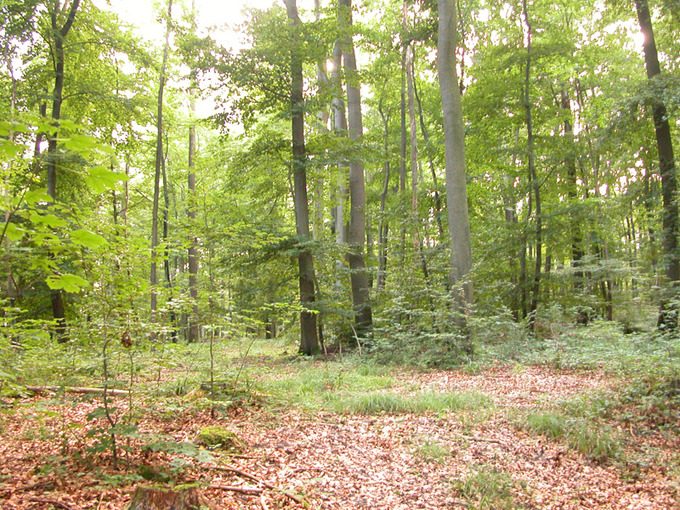
Deciduous trees: Deciduous trees, those that lose their leaves seasonally, are the ascendant institute in the temperate woods.
The trees of the temperate forests foliage out and shade much of the footing; however, this biome is more open than tropical moisture forests considering trees in the temperate forests do non grow as tall equally the trees in tropical wet forests. The soils of the temperate forests are rich in inorganic and organic nutrients due to the thick layer of leaf litter on wood floors. As this leaf litter decays, nutrients are returned to the soil. The leaf litter also protects soil from erosion, insulates the ground, and provides habitats for invertebrates (such as the pill bug or roly-poly, Armadillidium vulgare) and their predators, such equally the red-backed salamander (Plethodon cinereus).
Organisms Found in Temperate Deciduous Forests
The leaf litter is home to invertebrates (such as the pill bug or roly-poly, Armadillidium vulgare) and their predators, including the cherry-red-backed salamander (Plethodon cinereus). Pileated woodpeckers depend upon dead or dying trees equally a source of nutrient and for constructing their nests, and many migratory birds, such as the spring warblers, time their arrival to coincide with the opening of the tree awning, which provides the insects that are their principal nutrient sources for raising young. Many well-known animals are institute in temperate deciduous forests including squirrels, deer, and bears. The tiptop predators in deciduous forest were once wolves and cougars, but their populations have been in turn down.
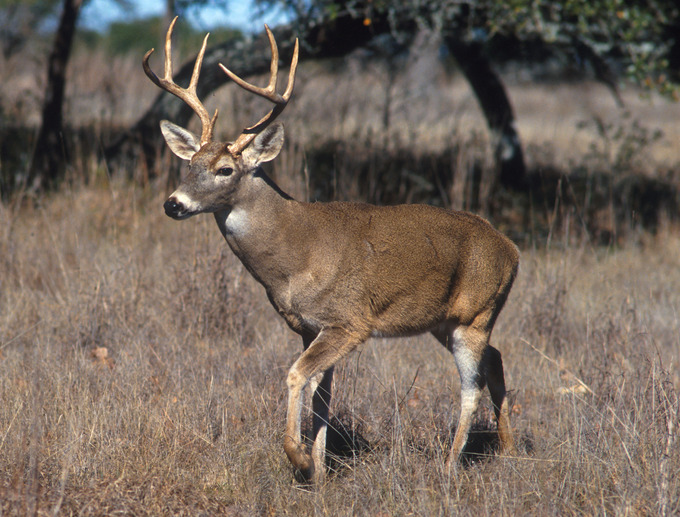
White-tailed deer: Deer such as the white-tailed deer of North America are mutual inhabitants of temperate forests.
Boreal Forests and Chill Tundra
The boreal wood is characterized by coniferous trees, while the arctic tundra is characterized by permanently frozen soils.
Learning Objectives
Recognize the distinguishing characteristics of boreal forests and chill tundra
Central Takeaways
Fundamental Points
- The boreal forest is found across well-nigh of Canada, Alaska, Russia, and northern Europe; the arctic tundra lies north of the boreal forest.
- The boreal forest has cold, dry winters and short, cool, wet summers with atmospheric precipitation that takes the form of snowfall; due to this environment, evergreen coniferous trees are the dominant plants.
- The soil in boreal forest regions is usually acidic and contains footling available nitrogen.
- Boreal forests take lower productivity than tropical or temperate forests; they also have less diversity, with but a tree layer and basis layer.
- Temperatures in the arctic tundra are common cold year-round and atmospheric precipitation is very low.
- Plants in the arctic tundra have a very curt growing season of approximately 10–12 weeks, but during this time, growth is rapid; plants are low to the ground and the soil is permanently frozen.
Key Terms
- permafrost: permanently frozen ground
- chill tundra: a biome found in the far Northern Hemisphere, north of the boreal forests, where the subsoil is permanently frozen
- boreal forest: a biome institute in the Northern Hemisphere and characterized by coniferous forests consisting mostly of pines, spruces, and larches
Boreal Forests
The boreal forest, also known as taiga or coniferous forest, the earth's largest terrestrial biome, is found south of the Arctic Circle and across most of Canada, Alaska, Russia, and northern Europe. This biome has cold, dry out winters and brusque, cool, wet summers. Temperatures vary from −54°C - 30°C (-65°F - 86°F) throughout the whole year. The summers, while short, are generally warm and boiling. In much of the taiga, -xx°C (-4°F) would exist a typical winter day temperature, while 18°C (64°F) would be an average summertime day.The annual precipitation, from 40 cm -100 cm (15.7–39 in), normally takes the class of snow. Little evaporation occurs considering of the cold temperatures.
The long and cold winters in the boreal forest have led to the predominance of cold-tolerant, cone-begetting plants. These are evergreen, coniferous trees such as pines, spruces, and firs, which retain their needle-shaped leaves year-circular. Evergreen trees can photosynthesize earlier in the spring than can deciduous copse because less energy from the sunday is required to warm a needle-like leaf than a wide leaf. This benefits evergreen trees, which grow faster than deciduous trees in the boreal forest. In addition, soils in boreal wood regions tend to be acidic, with trivial available nitrogen. Leaves are a nitrogen-rich structure that deciduous trees must produce yearly. Therefore, coniferous trees that retain nitrogen-rich needles may have a competitive reward over the broad-leafed deciduous trees.
The net master productivity of boreal forests is lower than that of temperate forests and tropical wet forests. The aboveground biomass of boreal forests is high because these slow-growing tree species are long-lived, accumulating continuing biomass over time. Establish species multifariousness is less than that seen in temperate forests and tropical moisture forests. Boreal forests lack the pronounced elements of the layered forest construction seen in tropical wet forests. The construction of a boreal woods is frequently simply a tree layer and a ground layer. When conifer needles are dropped, they decompose more slowly than do broad leaves; therefore, fewer nutrients are returned to the soil to fuel plant growth.
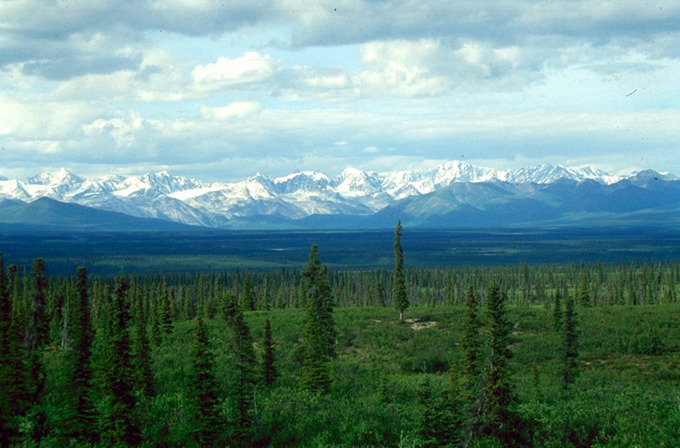
Plants in the boreal woods: The boreal woods (taiga) has low-lying plants and conifer copse; it oftentimes consists of merely a tree layer and a ground layer.
Chill Tundra
The Arctic tundra, lying northward of the subarctic boreal wood, is located throughout the Arctic regions of the northern hemisphere. The average winter temperature is -34°C (-29.2°F), while the average summertime temperature is from 3°C - 12°C (37°F - 52°F). Plants in the chill tundra have a very short growing flavour of approximately 10–12 weeks. However, during this time, in that location are almost 24 hours of daylight, so plant growth is rapid. The annual precipitation of the Arctic tundra is very low (about 15-25 cm), with petty annual variation in precipitation. Equally in the boreal forests, in that location is little evaporation due to the cold temperatures.
Plants in the Chill tundra are mostly low to the ground. There is little species diversity, low internet primary productivity, and low aboveground biomass. The soils of the Arctic tundra may remain in a perennially frozen land referred to as permafrost. The permafrost makes it impossible for roots to penetrate deep into the soil and slows the decay of organic matter, which inhibits the release of nutrients from organic matter. During the growing season, the ground of the Arctic tundra can be completely covered with plants or lichens.
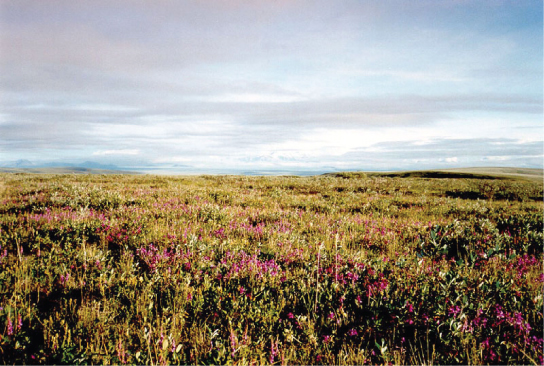
Plants in the Arctic tundra: Low-growing plants such as shrub willow dominate the tundra landscape, shown here in the Chill National Wild fauna Refuge.
The biodiversity of the tundras is low: there are 1,700 species of vascular plants and but 48 species of land mammals. Notable animals in the Chill tundra include caribou (reindeer ), musk ox, arctic hare, chill fox, snowy owl, lemmings, and polar bears. Due to the harsh climate, tundra regions have seen piddling human being action, even though they are sometimes rich in natural resource such as oil and uranium.
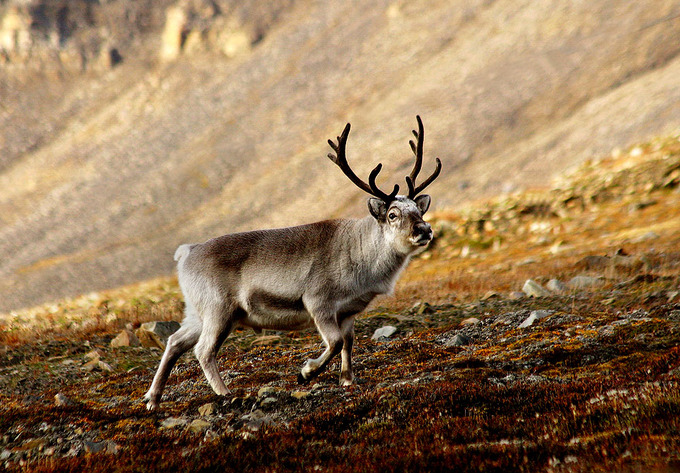
Caribou (reindeer) in the tundra: Some populations of the Due north American caribou migrate the farthest of any terrestrial mammal, traveling upwardly to v,000 km (3,100 mi) a year.
Licenses and Attributions
CC licensed content, Shared previously
- Curation and Revision. Provided by: Dizzying.com. License: CC BY-SA: Attribution-ShareAlike
CC licensed content, Specific attribution
- Environmental/Biological community. Provided by: Wikibooks. License: CC BY-SA: Attribution-ShareAlike
- Daniel Williamson, iii.1.two Biomes. December half dozen, 2013. Provided by: OpenStax CNX. Located at: https://cnx.org/contents/[email protected]. License: CC Past: Attribution
- OpenStax College, Terrestrial Biomes. Dec 7, 2013. Provided by: OpenStax CNX. License: CC Past: Attribution
- ecotone. Provided past: Wiktionary. License: CC By-SA: Attribution-ShareAlike
- habitat. Provided by: Wiktionary. License: CC BY-SA: Attribution-ShareAlike
- population. Provided past: Wiktionary. License: CC BY-SA: Attribution-ShareAlike
- biome. Provided by: Wiktionary. License: CC By-SA: Attribution-ShareAlike
- ecosystem. Provided by: Wiktionary. License: CC BY-SA: Attribution-ShareAlike
- OpenStax Higher, Terrestrial Biomes. December 7, 2013. Provided by: OpenStax CNX. Located at: https://cnx.org/contents/[email protected]. License: CC BY: Attribution
- OpenStax College, Biological science. October 17, 2013. Provided by: OpenStax CNX. License: CC BY: Attribution
- OpenStax College, Biological science. Oct 23, 2013. Provided by: OpenStax CNX. Located at: https://openstax.org/books/biological science/pages/44-three-terrestrial-biomes. License: CC Past: Attribution
- biome. Provided by: Wiktionary. License: CC BY-SA: Attribution-ShareAlike
- understory. Provided by: Wiktionary. License: CC BY-SA: Attribution-ShareAlike
- deciduous. Provided by: Wiktionary. License: CC BY-SA: Attribution-ShareAlike
- OpenStax Higher, Terrestrial Biomes. December 7, 2013. Provided by: OpenStax CNX. Located at: https://cnx.org/contents/[electronic mail protected]. License: CC Past: Attribution
- OpenStax College, Terrestrial Biomes. October 17, 2013. Provided by: OpenStax CNX. License: CC Past: Attribution
- OpenStax College, Terrestrial Biomes. Oct 17, 2013. Provided by: OpenStax CNX. Located at: https://cnx.org/resources/66a0be366aacd458afcbaa3faff605bed92431b6/Figure_44_03_03.jpg. License: CC By: Attribution
- OpenStax College, Biological science. December six, 2013. Provided by: OpenStax CNX. Located at: https://openstax.org/books/biology/pages/44-iii-terrestrial-biomes. License: CC BY: Attribution
- Boundless. Provided past: Boundless Learning. Located at: https://www.dizzying.com/. License: CC BY: Attribution
- OpenStax College, Biology. October 17, 2013. Provided by: OpenStax CNX. Located at: https://openstax.org/books/biological science/pages/44-3-terrestrial-biomes. License: CC BY: Attribution
- chaparral. Provided past: Wiktionary. License: CC BY-SA: Attribution-ShareAlike
- Boundless. Provided by: Boundless Learning. License: CC BY-SA: Attribution-ShareAlike
- OpenStax Higher, Terrestrial Biomes. December seven, 2013. Provided past: OpenStax CNX. Located at: https://cnx.org/contents/[email protected]. License: CC Past: Attribution
- OpenStax Higher, Terrestrial Biomes. October 17, 2013. Provided past: OpenStax CNX. License: CC By: Attribution
- OpenStax Higher, Terrestrial Biomes. Oct 17, 2013. Provided by: OpenStax CNX. Located at: https://cnx.org/resources/66a0be366aacd458afcbaa3faff605bed92431b6/Figure_44_03_03.jpg. License: CC By: Attribution
- OpenStax College, Biology. Dec half-dozen, 2013. Provided by: OpenStax CNX. Located at: https://openstax.org/books/biology/pages/44-3-terrestrial-biomes. License: CC Past: Attribution
- OpenStax College, Terrestrial Biomes. October 17, 2013. Provided by: OpenStax CNX. License: CC Past: Attribution
- OpenStax College, Terrestrial Biomes. October 17, 2013. Provided past: OpenStax CNX. Located at: https://cnx.org/resources/c9b36c6f30e010669667b41f6efc65c49310e5f9/Figure_44_03_04.jpg. License: CC BY: Attribution
- Fennec play a joke on. Provided by: Wikipedia. Located at: https://en.wikipedia.org/wiki/Fennec_fox. License: CC Past-SA: Attribution-ShareAlike
- OpenStax College, Biology. October 17, 2013. Provided by: OpenStax CNX. Located at: https://openstax.org/books/biology/pages/44-3-terrestrial-biomes. License: CC By: Attribution
- steppe. Provided by: Wiktionary. License: CC By-SA: Attribution-ShareAlike
- prairie. Provided past: Wiktionary. License: CC BY-SA: Attribution-ShareAlike
- OpenStax College, Terrestrial Biomes. December seven, 2013. Provided by: OpenStax CNX. Located at: https://cnx.org/contents/[email protected]. License: CC By: Attribution
- OpenStax Higher, Terrestrial Biomes. October 17, 2013. Provided past: OpenStax CNX. License: CC BY: Attribution
- OpenStax College, Terrestrial Biomes. October 17, 2013. Provided by: OpenStax CNX. Located at: https://cnx.org/resources/66a0be366aacd458afcbaa3faff605bed92431b6/Figure_44_03_03.jpg. License: CC BY: Attribution
- OpenStax Higher, Biology. December 6, 2013. Provided by: OpenStax CNX. Located at: https://openstax.org/books/biology/pages/44-three-terrestrial-biomes. License: CC Past: Attribution
- OpenStax College, Terrestrial Biomes. October 17, 2013. Provided by: OpenStax CNX. License: CC BY: Attribution
- OpenStax College, Terrestrial Biomes. October 17, 2013. Provided by: OpenStax CNX. Located at: https://cnx.org/resources/c9b36c6f30e010669667b41f6efc65c49310e5f9/Figure_44_03_04.jpg. License: CC Past: Attribution
- Fennec fox. Provided by: Wikipedia. License: CC By-SA: Attribution-ShareAlike
- New Zealand tussock grasslands. Provided by: Wikipedia. License: Public Domain: No Known Copyright
- OpenStax College, Terrestrial Biomes. October 17, 2013. Provided past: OpenStax CNX. Located at: https://cnx.org/resources/f383be2466bba32b50aaf0ff3ac46fc9356ee63a/Figure_44_03_06.jpg. License: CC BY: Attribution
- Przewalski'south horse. Provided by: Wikipedia. License: Public Domain: No Known Copyright
- deciduous. Provided past: Wiktionary. License: CC BY-SA: Attribution-ShareAlike
- OpenStax College, Biology. Oct 17, 2013. Provided by: OpenStax CNX. Located at: https://openstax.org/books/biology/pages/44-3-terrestrial-biomes. License: CC Past: Attribution
- temperate forest. Provided by: Wikipedia. License: CC Past-SA: Attribution-ShareAlike
- OpenStax College, Terrestrial Biomes. December 7, 2013. Provided by: OpenStax CNX. Located at: https://cnx.org/contents/[email protected]. License: CC BY: Attribution
- OpenStax College, Terrestrial Biomes. October 17, 2013. Provided by: OpenStax CNX. License: CC Past: Attribution
- OpenStax College, Terrestrial Biomes. October 17, 2013. Provided by: OpenStax CNX. Located at: https://cnx.org/resources/66a0be366aacd458afcbaa3faff605bed92431b6/Figure_44_03_03.jpg. License: CC BY: Attribution
- OpenStax College, Biology. December 6, 2013. Provided past: OpenStax CNX. Located at: https://openstax.org/books/biological science/pages/44-3-terrestrial-biomes. License: CC BY: Attribution
- OpenStax College, Terrestrial Biomes. October 17, 2013. Provided by: OpenStax CNX. License: CC BY: Attribution
- OpenStax College, Terrestrial Biomes. Oct 17, 2013. Provided by: OpenStax CNX. Located at: https://cnx.org/resources/c9b36c6f30e010669667b41f6efc65c49310e5f9/Figure_44_03_04.jpg. License: CC Past: Attribution
- Fennec fox. Provided past: Wikipedia. Located at: https://en.wikipedia.org/wiki/Fennec_fox. License: CC BY-SA: Attribution-ShareAlike
- New Zealand tussock grasslands. Provided by: Wikipedia. License: Public Domain: No Known Copyright
- OpenStax College, Terrestrial Biomes. Oct 17, 2013. Provided by: OpenStax CNX. Located at: https://cnx.org/resources/f383be2466bba32b50aaf0ff3ac46fc9356ee63a/Figure_44_03_06.jpg. License: CC By: Attribution
- Przewalski's equus caballus. Provided by: Wikipedia. License: Public Domain: No Known Copyright
- OpenStax College, Terrestrial Biomes. October 17, 2013. Provided past: OpenStax CNX. Located at: https://cnx.org/resources/040922c8984c50fa4fdd75a8eeb21ea6f2e3a3a5/Figure_44_03_07.jpg. License: CC Past: Attribution
- Deer. Provided by: Wikipedia. License: Public Domain: No Known Copyright
- OpenStax College, Biology. October 17, 2013. Provided by: OpenStax CNX. Located at: https://openstax.org/books/biology/pages/44-3-terrestrial-biomes. License: CC BY: Attribution
- OpenStax College, Biology. October 23, 2013. Provided past: OpenStax CNX. License: CC BY: Attribution
- Tundra. Provided by: Wikipedia. License: CC BY-SA: Attribution-ShareAlike
- Taiga. Provided past: Wikipedia. License: CC Past-SA: Attribution-ShareAlike
- boreal forest. Provided by: Wikipedia. License: CC By-SA: Attribution-ShareAlike
- chill tundra. Provided by: Wikipedia. License: CC BY-SA: Attribution-ShareAlike
- permafrost. Provided by: Wiktionary. License: CC BY-SA: Attribution-ShareAlike
- OpenStax College, Terrestrial Biomes. December 7, 2013. Provided past: OpenStax CNX. Located at: https://cnx.org/contents/[electronic mail protected]. License: CC Past: Attribution
- OpenStax College, Terrestrial Biomes. October 17, 2013. Provided by: OpenStax CNX. License: CC Past: Attribution
- OpenStax College, Terrestrial Biomes. October 17, 2013. Provided past: OpenStax CNX. Located at: https://cnx.org/resource/66a0be366aacd458afcbaa3faff605bed92431b6/Figure_44_03_03.jpg. License: CC Past: Attribution
- OpenStax Higher, Biology. Dec vi, 2013. Provided past: OpenStax CNX. Located at: https://openstax.org/books/biology/pages/44-3-terrestrial-biomes. License: CC Past: Attribution
- OpenStax College, Terrestrial Biomes. October 17, 2013. Provided by: OpenStax CNX. Located at: https://cnx.org/resources/4cb89c4e7c7bcdbcd3c2cf243f8f1b7d3268d450/Figure_44_03_05.jpg. License: CC By: Attribution
- OpenStax College, Terrestrial Biomes. Oct 17, 2013. Provided past: OpenStax CNX. Located at: https://cnx.org/resource/c9b36c6f30e010669667b41f6efc65c49310e5f9/Figure_44_03_04.jpg. License: CC Past: Attribution
- Fennec fox. Provided by: Wikipedia. License: CC BY-SA: Attribution-ShareAlike
- New Zealand tussock grasslands. Provided by: Wikipedia. License: Public Domain: No Known Copyright
- OpenStax College, Terrestrial Biomes. October 17, 2013. Provided by: OpenStax CNX. Located at: https://cnx.org/resources/f383be2466bba32b50aaf0ff3ac46fc9356ee63a/Figure_44_03_06.jpg. License: CC By: Attribution
- Przewalski's equus caballus. Provided by: Wikipedia. License: Public Domain: No Known Copyright
- OpenStax College, Terrestrial Biomes. October 17, 2013. Provided by: OpenStax CNX. Located at: https://cnx.org/resources/040922c8984c50fa4fdd75a8eeb21ea6f2e3a3a5/Figure_44_03_07.jpg. License: CC Past: Attribution
- Deer. Provided by: Wikipedia. License: Public Domain: No Known Copyright
- OpenStax Higher, Terrestrial Biomes. October 17, 2013. Provided by: OpenStax CNX. Located at: https://cnx.org/resource/74fae94f0fe6a09b6fd9b7030f1120669a95ecf7/Figure_44_03_09.jpg. License: CC Past: Attribution
- Reindeer. Provided by: Wikipedia. License: Public Domain: No Known Copyright
- OpenStax College, Terrestrial Biomes. Oct 17, 2013. Provided by: OpenStax CNX. Located at: https://cnx.org/resources/c39fed450698872865dba58d755f0ecf1c5610bd/Figure_44_03_08.jpg. License: CC By: Attribution
Source: https://www.coursehero.com/study-guides/boundless-biology/terrestrial-biomes/
Posted by: mayhewsionech1955.blogspot.com

0 Response to "Which Terrestrial Geographic Zones Tend To Have The Highest Plant And Animal Biodiversity"
Post a Comment